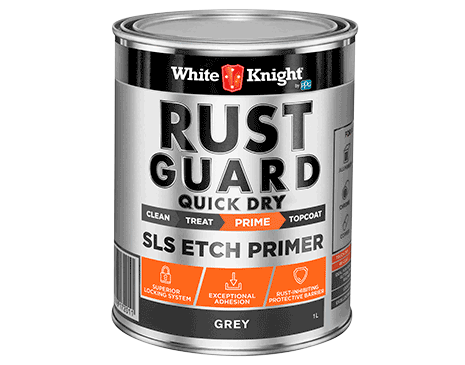Features
• Anti-corrosive
• Locks into metal
• Exceptional adhesion & durability
• Excellent base for topcoats
• Safe to spray - CFC and lead free
• Non chroming formula
Where To Use
White Knight Rust Guard SLS Etch Primer is suitable for aluminium, galvanized iron, brass and copper.
Ideal on fences, railings, gutter, roofs, doors, pipes and gates
How To Apply
1. PREPARATION
AEROSOL:
- Remove all rust and flaking paint back to bare metal with a wire brush, scraper or mechanical sander.
- The surface must be clean, dry and free from dust, dirt, grease, oil, rust scale and other contaminants.
- Cover all necessary areas to protect from overspray.
BRUSH ON:
- Remove all rust and flaking paint back to bare metal with a wire brush, scraper or mechanical sander.
- The surface must be clean, dry and free from dust, dirt, grease, oil, rust scale and other contaminants.
2. APPLICATION
AEROSOL:
- Shake can vigorously for 1 minute before use and regularly during use.
- Hold the can upright approximately 15-20 cm from the surface.
- Press button firmly and spray with a smooth sweeping motion. Apply a pre-wetting mist coat followed by a full even coat, overlapping each spray pass. To prevent paint sagging, avoid spraying too close to the surface or spraying too heavily.
- Repeat if necessary.
Do not use when air or surface temperature is below 15°C or above 30°C.
BRUSH ON:
- Stir thoroughly with a broad flat stirrer in a circular lifting motion for at least 5 minutes before use and continue to stir at regular intervals during application.
- No thinning is required for application by brush or roller. If spraying with a spray gun, you may thin up to 10% with White Knight Rust Guard Solvent.
- Apply 1 coat by brush, roller or spray gun.
Do not use when air or surface temperature is below 10°C or above 30°C
3. OVER COATING
AEROSOL: Overcoat between 1 and 24 hours after application with an enamel or water based topcoat.
BRUSH ON: Overcoat between 2 and 24 hours after application with an enamel or water based topcoat.
4. COVERAGE
AEROSOL: Approximately 1.5m² per can
BRUSH ON: Approximately 14m² per litre, depending on the nature of the surface
5. DRYING
AEROSOL: Touch dry in 10 minutes.
BRUSH ON: Touch dry in 10 minutes.
Drying will be slower in cold or humid conditions, in the absence of ventilation or where heavy film builds are applied.
6. CLEAN
AEROSOL: To prevent nozzle blocking, after use turn can upside down and press button until only gas escapes. Overspray can be removed while still wet with White Knight Rust Guard Solvent or methylated spirits.
BRUSH ON: Clean brushes and equipment with White Knight Rust Guard® Solvent immediately after use.
7. SAFETY & FIRST AID
AEROSOL:
KEEP OUT OF REACH OF CHILDREN.
- If swallowed, seek medical advice immediately and show the container or label. Do not induce vomiting.
- If in eyes, immediately flush with running water for at least 15 minutes. Seek immediate medical attention.
- Avoid breathing vapour or mist.
- Use only with adequate ventilation.
- If on skin, remove contaminated clothing. Wash skin thoroughly with soap and water. Do not use solvents or thinners.
Warning - Misuse by concentrating and inhaling contents can be harmful or fatal.
BRUSH ON:
KEEP OUT OF REACH OF CHILDREN.
- This product is highly flammable. Store and use away from heat and eliminate any source of ignition.
- If swallowed seek medical advice immediately and show the container or label. Do not induce vomiting.
- If in eyes, immediately flush with running water for at least 15 minutes. Seek immediate medical attention.
- If on skin, remove contaminated clothing. Wash skin thoroughly with soap and water. Do not use solvents or thinners.
- Avoid breathing vapor or mist.
- Use only with adequate ventilation.
For 24 hour medical emergency response service in Australia call 1800 883 254 and in New Zealand call 0800 000 096
Need Help?
It’s as easy as selecting a project type and the material involved
